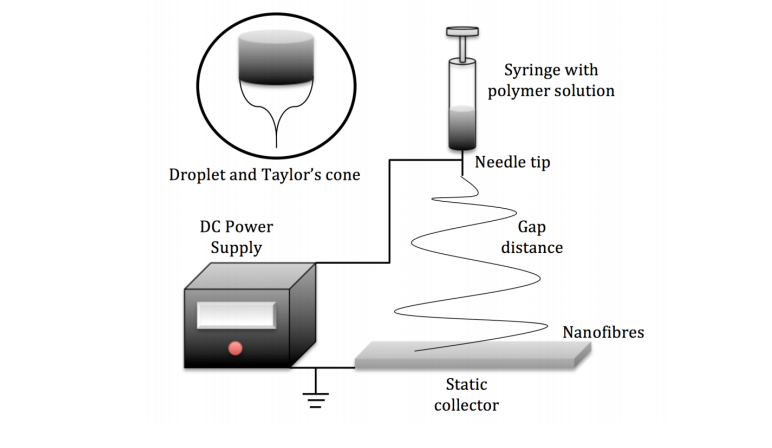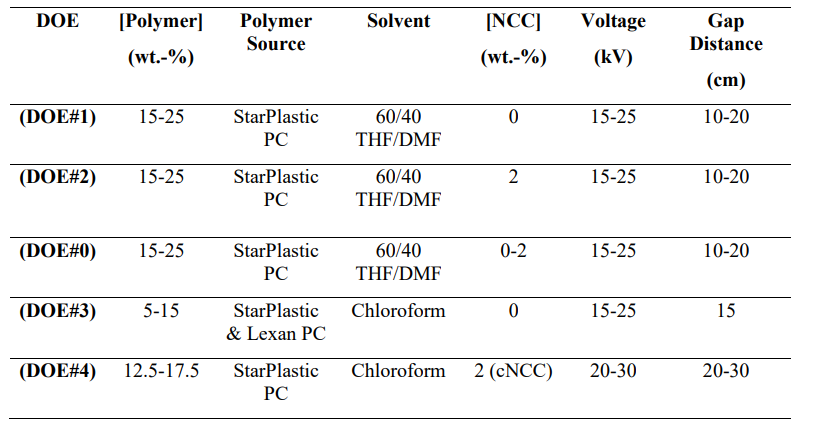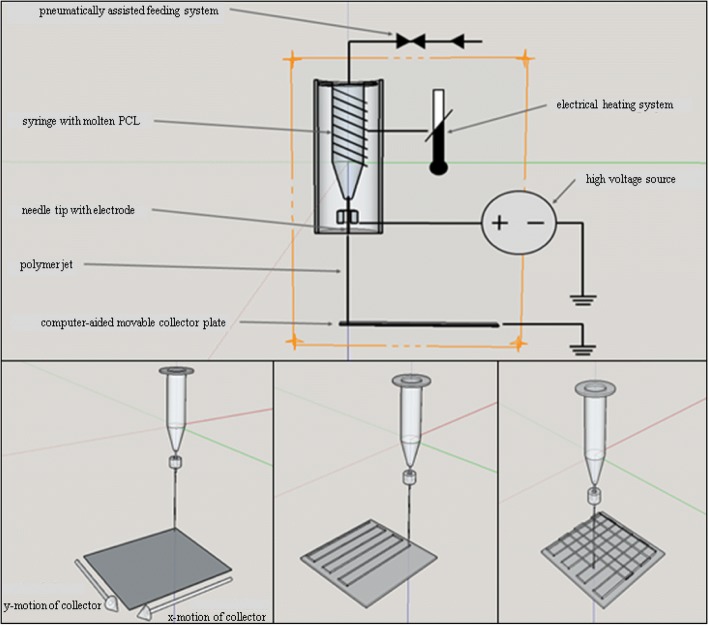University of Waterloo: Cellulosic Nanocomposites in Additive Manufacturing & Electrospinning
Andrew Finkle recently presented a thesis to the University of Waterloo, exploring the potential for more effective materials. In ‘Cellulosic Nanocomposites for Advanced Manufacturing: An Exploration of Advanced Materials in Electrospinning and Additive Manufacturing,’ Finkle continues the trend in refining techniques and additives for better performance.
This study centers around polymer nanocomposites; however, today researchers and manufacturers around the world are engaged in research using additives to create other unique materials too like composite hydrogels, bronze PLA, and composite SLS—all in hopes of accentuating specific projects which may require different mechanical properties or distinct features related to functionality.
In terms of hardware and techniques, Finkle examines both electrospinning and fused filament fabrication (FFF) for use with thermoplastic nanocomposites in the production of electrospun fiber mats and 3D printed parts. The new filaments developed in this study contain reinforcements like nanocrystalline cellulose (NCC), meant to improve mechanical properties over traditional methods.
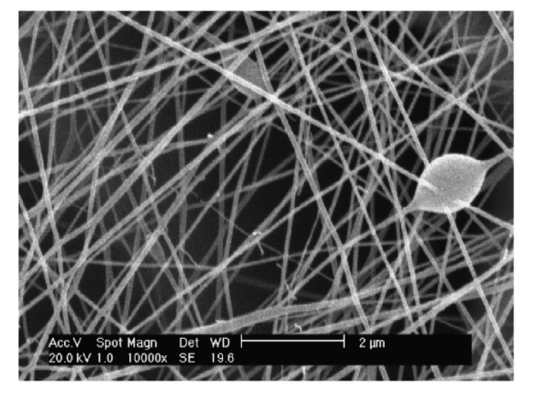
Typical morphology of electrospun polyamide-6 nanofibers observed with scanning electron microscope [4].
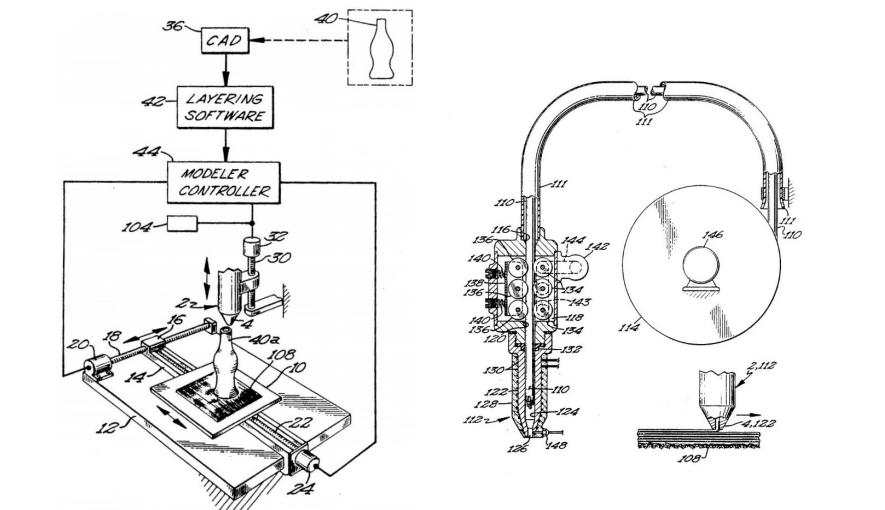
Schematic diagrams of fused deposition modeling (FDM) of thermoplastics from the patent “Apparatus and method for creating three-dimensional objects” by S. Crump including an FDM i) 3D printer and ii) extrusion head [8]
Nanocrystalline cellulose (NCC) is a derivative of wood pulp and has demonstrated potential for use as an additive for polymer composites—and specifically for this study, to accompany polycarbonate (PC)—a material offering a wide range of benefits, to include:
- Heat resistance
- Impact strength
- Rigidity
- Toughness
“The typical NCC whisker is on the order of 10 nm by 200 nm comprised of many cellulose β-glucan chains tightly bound together to form a very strong crystalline material,” explained Finkle. “The theoretical strength of NCC is on the order 9 of stainless steel and carbon nanotubes but unlike these inorganic reinforcements, is made from renewable and biocompatible sources.”
“The high strength makes this nanoparticle a great candidate for incorporation into composites and more specifically electrospun nanofibers.”
Electrospun mat morphology was based on the following:
- Fiber diameter
- Bead diameter
- Bead density
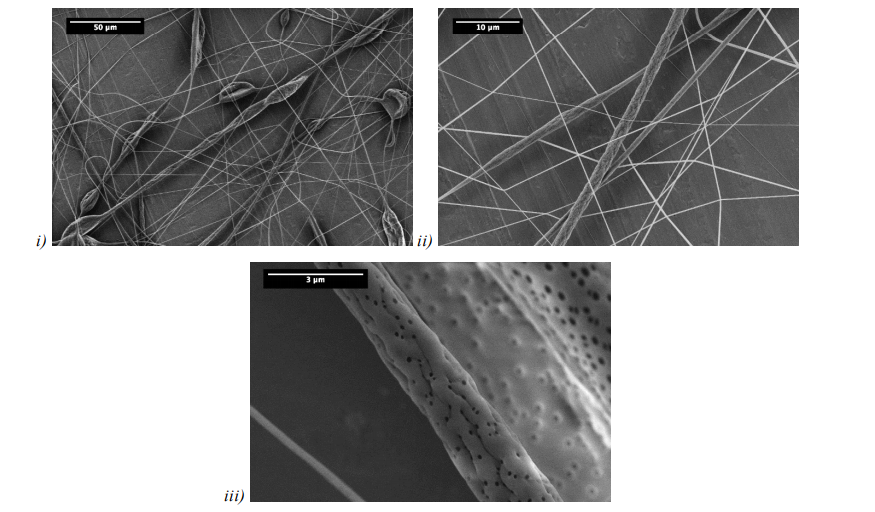
SEM micrographs of 15 wt-% PC nanofibers electrospun using chloroform. Fibers i) and ii) were electrospun using Vapp = 20 kV and iii) using Vapp = 15 kV over a gap distance of 15 cm.
“The formulation parameters chosen to explore within the DOEs are the polymer concentration in the solution, the concentration of additives (NCC). The processing parameters chosen to explore within each DOE included the applied voltage, Voltage, and gap distance, Gap Distance. Between the DOEs two other formulation parameters were explored,” explained Finkle.
“This included the solvent the polycarbonate solution was made in either a 60/40 (w/w) THF/DMF mixture or chloroform, both good solvents for PC. The second variable introduced between DOEs with the same solvent was 2-wt.-% of NCC (or DDSA-modified NCC, cNCC) in the solid mass (not including solvent).”
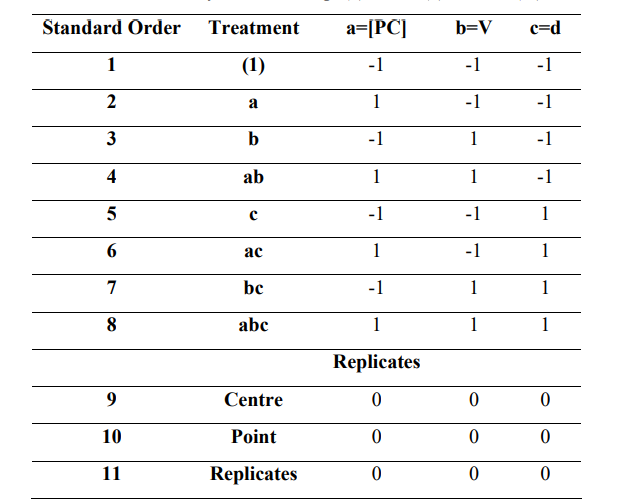
Standard order of experiments for a 23 full factorial DOE including the treatment shorthand notation and coded factor levels; high (1), center (0), and low (-1)
Design of experiments (DOEs) were investigated in terms of response to model fiber diameters in terms of:
- Function of the PC concentration
- NCC concentration
- Applied voltage
- Gap distance
Center-point measurements evaluated curvatures in the model, and solution properties were noted.

full factorial DOE#1, including the three different factors tested (coded a, b, and c) with their low (-1), high (+1), and center point (0) values
“For most of the experimentation, this involved: following a schedule, often electrospinning as soon as possible following sample preparation; minimizing any error in formulation and mixing of solutions; repeatable collection of nanofiber mats, as well as sample collection, preparation, and imaging of experimental specimens,” concluded Finkle.
“Although controlled as best as possible, some anomalies have still appeared. In particular, the center point replicates of DOE#4 – DDSA-modified Nanocrystalline Cellulose (cNCC) + Chloroform observed in Figure 4.30 show significant variance even though the experimental conditions were identical. This demonstrates that not only that electrospinning in volatile solvents like chloroform at room temperature is difficult to control, but that all possible variables for electrospinning must be considered carefully to achieve desired results.”
What do you think of this news? Let us know your thoughts! Join the discussion of this and other 3D printing topics at 3DPrintBoard.com.
[Source / Images: ‘Cellulosic Nanocomposites for Advanced Manufacturing: An Exploration of Advanced Materials in Electrospinning and Additive Manufacturing’]
The post University of Waterloo: Cellulosic Nanocomposites in Additive Manufacturing & Electrospinning appeared first on 3DPrint.com | The Voice of 3D Printing / Additive Manufacturing.
3D Printed Meat: Great Potential for the Future, But Challenges Still Persist
In ‘Application of 3D Printing in Meat Production,’ researchers delve further into the possibilities of additive manufacturing with food. While there have been some forays into 3D fabrication with meat, most viable production of food has related more to extrusion of sweets, breads, and items more conducive to being expressed through a nozzle. The authors point out that some of the greatest benefits in 3D printing can be translated to use with food as so many consumers today have special dietary needs—and 3D printing technology allows for complete customization, even with the possibility of adding specific vitamins to food, along with flavors and different structures.
Food customization is certainly nothing new, as chefs around the world have been creating special dishes for eons; however, ‘artisans’ today are often challenged in creating one-of-a-kind dishes as such an exercise can be cost-prohibitive.
“Digital gastronomy brings in cooking knowledge into food fabrication so that our eating experience can go beyond merely taste and cover all the aspects of gastronomy,” state the researchers.
So many different health conditions can be addressed too, and especially for individuals who may have trouble eating, chewing, or swallowing their food. The research team explains that the greatest potential for customized food lies in 3D printing techniques such as:
- Extrusion
- Inkjet printing
- Binding deposition
- Bioprinting
Their number one choice for creating food, however, is a natural one, with extrusion:
“The syringe-based extrusion unit is suitable to print food materials with high viscosity and high mechanical strength, to fabricate complex 3D structures with high resolution. The air pressure-based extrusion and syringe-based extrusion do not allow the continuous feeding of food materials during printing. The viscosity of the soft material should be both low enough to be easily extruded through a fine nozzle, and high enough to hold the subsequently deposited layers,” stated the researchers.
Significant challenges are still present, however, regarding precision in fabrication, performance in processing, and issues with flavor, structure, and ‘binding mechanisms.’ So far, most processing of meat in 3D printing has been in a slurry form, which makes sense for extrusion; however, this may not be conducive to presenting a gourmet product by any stretch. The addition of other binding components, however, like gelatin, should improve meat processing.
Techniques such as electrospinning may also be beneficial, resulting in meat that is the desired shape and size, created of strong micro-fibers. Electrospinning can also be more conducive to good flavor due to the fibrous advantage. Microencapsulation is another technique that could be useful as it compresses vitamins and minerals and oils together, feasibly with a multi-print head system.
“For a better understanding of its printability, as well as the 3DP settings and post-processing conditions of the printed product is required to optimize formulation through the rheological and mechanical properties for beef paste. Further research may be conducted with beef materials in order to improve its nutrutional value and sensorial profile by means of addition of bioactive ingredients and including complex internal structures, respectively,” concluded the researchers.
“Applying new technologies to 3D food printing like electrospinning and encapsulation can help improving 3D printed meat products and become a potential way to fabricate on demand products.”

Other companies such as Oceanz and Cooperative Door are experimenting with creating 3D printed veggies via recycled food waste (Photo: ‘Oceanz and Cooperative DOOR Partner to Stop Food Waste with 3D Printed Vegetables‘)
3D printing and food are one of the most tantalizing subjects, and while the fabrication of meat is certainly an interesting concept, researchers over the past few years have also brought 3D printed chocolate, pancakes, a variety of savory items, and so much more to our attention. Ultimately, consumers should have much more control over how their food is processed and made at home, as well as in restaurants, and many institutional settings.
What do you think of this news? Let us know your thoughts! Join the discussion of this and other 3D printing topics at 3DPrintBoard.com.
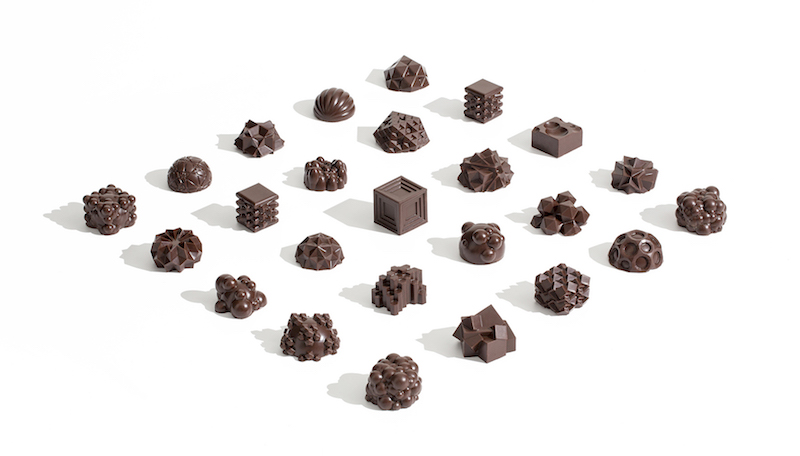
3D printed chocolate is extremely popular among enthusiasts (photo: Artist Ryan L. Foote, in ‘These 3D Printed Chocolates Are Inspired By Natural Wonders and Exotic Locales‘)
[Source / Image: Application of 3D Printing in Meat Production]
Researchers Explore Melt Electrospinning & 3D Printed Scaffolds for Guided Bone Regeneration
 Recent research by scientists at University Hospital Würzburg yields new insight into the uses of 3D printing in creating scaffolding for oral bone regeneration, offering results in ‘Medical-grade polycaprolactone scaffolds made by melt electrospinning writing for oral bone regeneration – a pilot study in vitro.’
Recent research by scientists at University Hospital Würzburg yields new insight into the uses of 3D printing in creating scaffolding for oral bone regeneration, offering results in ‘Medical-grade polycaprolactone scaffolds made by melt electrospinning writing for oral bone regeneration – a pilot study in vitro.’
The use of scaffolds has been rife with challenges, and especially in guided bone regeneration (GBR). Problems include issues with handling in clinical environments, erratic degradation, lack of stability in cell growth, and more. The researchers in this case embarked on a study of scaffolds created through melt electrospinning writing (MEW) and consequent 3D printing, creating complex scaffold geometrics that can be fabricated specifically to bone tissue requirements—usually in maxillofacial applications.
“In general, membranes that are currently used for maxillofacial applications, such as GBR, can be broadly divided into resorbable and non-resorbable categories,” state the researchers. “Membranes of the latter category offer good biocompatibility and high mechanical stability. Thus, they suit very well as placeholders and barriers in GBR. On the other hand, non-resorbable membranes require a second operation for their removal, pose a risk of mucosal perforations due to their high level of stiffness and therefor go along with higher morbidity, increased costs and increased expenditure of time.”
Electrospinning offers a comparatively easy way to make scaffolds necessary to biomedical applications, employing a charged polymer jet pushed out from a spinneret and ‘drawn’ toward an area well fibers begin to form into a structure. For creating polymers, both solution electrospinning and MEW are used.
MEW allows the operator to place fibers exactly, and without chemicals and solvents, meaning there is also no potential for solvents to be left in the scaffold.
“Process parameters allow for a controlled fiber placement, which makes the computer-aided design- and manufacturing (CAD/CAM) of 3D scaffolds feasible. Cell growth on scaffolds can thus be optimized by varying pore sizes and interconnectivity,” explain the researchers.
All scaffolds for the study were made of medical-grade PCL and the researchers were able to use a MEW device that was customized by the Department for Functional Materials in Medicine and Dentistry Würzburg University Hospital. Cells were assessed and quantified, and then washed, sealed, and neutralized. Testing revealed good viability and proliferation.
“The architecture of scaffolds, size, morphology and interconnectivity play an important role in the sufficient regeneration of bone,” state the researchers.
“Such scaffolds/membranes would prove beneficial, especially in the field of oral and maxillofacial surgery, where impaired wound healing in the alveolus region oftentimes poses problems. Furthermore, a pre-implantological use of these membranes seems suitable. In atrophic regions of the alveolus in which elaborate bone augmentation is necessary, coverage with membranes that additionally promote bone healing should prove a promising approach to improved GBR.”
End results showed not only good viability but also protein concentration, and cell number.
“These well-defined 3D scaffolds consisting of medical-grade materials optimized for cell attachment and cell growth hold the key to a promising new approach in GBR in oral and maxillofacial surgery,” concluded the researchers.
3D printing has lent so much to the world of innovation, from aerospace to fashion and beyond, but this technology has had significant impacts in medicine, and in areas that are vital but that many of us rarely think about or even know about, such as scaffolding.
What do you think of this news? Let us know your thoughts! Join the discussion of this and other 3D printing topics at 3DPrintBoard.com.
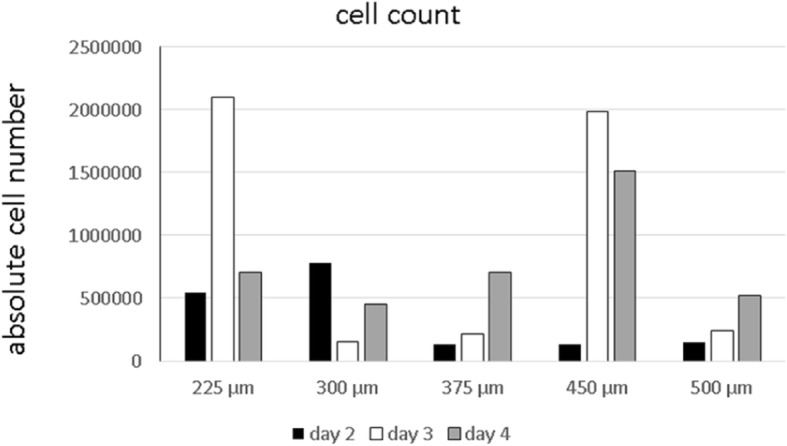
Cell count of MG63 cells seeded on MEW box structured PCL scaffolds of different box-sizes after 2, 3 and 4 days of cell culture
[Source / Images: Medical-grade polycaprolactone scaffolds made by melt electrospinning writing for oral bone regeneration – a pilot study in vitro]
3D Printed Ligaments Could Change the Way Common Injuries are Treated
Ligament tears are becoming more common in sports. They’re painful and debilitating, and difficult to treat. The current standard is to replace the torn ligament with tendons, but that can cause additional problems down the line.
“What can happen over time is that the tendon itself begins to kind of stretch and become a little bit relaxed in the joint,” said Christina Salas, PhD, a scientist at the University of New Mexico. “Then (the tendon) becomes deficient again.”
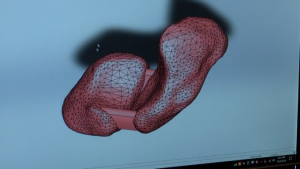 Dr. Salas is currently working on creating 3D printed ligaments, which she says has never been done before. It’s an area of focus she has been working on for some time, with help from students and professors at the University of New Mexico.
Dr. Salas is currently working on creating 3D printed ligaments, which she says has never been done before. It’s an area of focus she has been working on for some time, with help from students and professors at the University of New Mexico.
“This is something that hopefully can reduce some of those failures we see,” said Dustin Richter, Assistant Professor of Sports Medicine and Orthopedic Surgery. “And get people back to doing what they enjoy.”
The researchers have developed a special technique involving electrospinning, which uses electric force to create fibers.
“The near-field electrospinning technique that we have added to the bio-printer actually produces really highly aligned fibers that replicate the ligament tissue,” said Dr. Salas.
Doctors could then take a CT or MRI scan of a patient’s damaged joint and create an exact replica using 3D printing. This could allow for less-invasive surgery, and could be a more permanent solution as the synthetic 3D printed ligament would not wear out or weaken.
“We want to make sure that those patients can truly maintain their full function even longer as they grow older in life,” said Dr. Salas.
The biggest challenge Dr. Salas and her colleagues are facing is figuring out how to attach the 3D printed ligaments to the bone. Dr. Salas recently received a two-year, $150,000 grant for the research.
3D printing is changing the way doctors and scientists look at the treatment of common injuries, such as torn ligaments. Recently, Queensland researchers revealed a new method of 3D printing joint cartilage, which could greatly shorten recovery time after surgery for arthritis and joint injuries – and that’s only one example of the extensive research that is taking place around the world involving the use of 3D printing for the repair of damaged bones and muscles.
Dr. Salas’ research involves artificial ligaments, but other work is taking place that involves 3D printing new tissue using the patient’s own stem cells. Many people automatically jump directly to talking about 3D printing organs when 3D bioprinting is mentioned, but major progress is being made in other areas, like the treatments of degenerative illnesses and common injuries. With 3D printing, athletes have the potential to stay in the game for much longer than they would have otherwise. There may also be less need for things like walkers and wheelchairs as people age, as diseases like arthritis are healed with new cartilage.
When 3D printed organs eventually become realized, they will potentially enable people to live longer than ever before. Until then, bioprinting has the ability to help people live with better quality of life for their natural lifespans.
Discuss this and other 3D printing topics at 3DPrintBoard.com or share your thoughts below.
[Source: KRQE]
3D Printing and Electrospinning PCL for Dressings and Wound Repair
 When the body is functioning as it should, wounds repair themselves naturally. Sometimes, however, wounds do not heal, due to conditions such as diabetes or other chronic diseases. This puts the patient at risk of infection and other complications, at worst even requiring amputation. Chronic wounds affect 37 million patients around the world, and there is a great need for better treatment of these wounds.
When the body is functioning as it should, wounds repair themselves naturally. Sometimes, however, wounds do not heal, due to conditions such as diabetes or other chronic diseases. This puts the patient at risk of infection and other complications, at worst even requiring amputation. Chronic wounds affect 37 million patients around the world, and there is a great need for better treatment of these wounds.
In her Master’s Degree thesis, Politecnico di Torino student Viola Sgarminato discusses how 3D bioprinting and electrospinning can create scaffolds that actually promote wound repair. Using a combination of electrospinning and 3D printing with an EnvisionTEC 3D-Bioplotter, Sgarminato developed scaffolds that would promote healing by electrically stimulating skin cells.
“To this aim hierarchical scaffolds of polycaprolactone (PCL) and piezoelectric barium titanate (BaTiO3) nanoparticles were fabricated using 3D-bioprinting and the electrospinning technique,” Sgarminato explains.
Electrospinning is a technique that has been used for decades, and it involves the use of an electric charge to spin nanometer threads from a polymer solution. Lately, it’s been frequently used in conjunction with 3D printing, particularly bioprinting. In one part of the study, Sgarminato used the technique to create fibrous patches. She also used a 3D-Bioplotter to 3D print scaffolds for skin regeneration.
“In this work the bio-plotting technique was used to produce polycaprolactone (PCL) scaffolds with and without barium titanate nanoparticles,” she says. “Several sample thicknesses, porosities and geometries were tested to obtain optimized scaffolds for skin regeneration. Low and high temperature processes were performed to produce piezoelectric and nonpiezoelectric scaffolds, respectively. Indeed, to print scaffolds with homogenously distributed BTNPs, a solution of PCL and consequently a low temperature process are needed.”
The scaffolds were seeded with cells, which were then evaluated 24 and 72 hours later.
For the electrospinning portion of the project, one solution, in particular, worked better at producing defect-free mats of fibers – PCL was the key ingredient. The 3D printed scaffolds were examined to test their porosity, and to compare those that were produced through high temperature and low-temperature 3D printing. The composite wound dressings were also examined using a scanning electron microscope to verify the adhesion of the fibers to the scaffold, and good results were shown: even if subjected to mechanical stretching, the fibers remained attached to the substrate.
“The results that have been measured in 3T3 cells after 24h from seeding demonstrate that the cellular adhesion is comparable for each substrate,” says Sgarminato. “By considering the absorbance values after 72h, the highest increment of proliferation occurs for samples 4,5 and 6 that correspond to the PCL nanofibers…Indeed, PCL electrospun nanofibers represent a suitable substrate for growth and proliferation of NIH 3T3 cells. The small differences between PCL nanofibers and composites (samples 7 and 8) suggest a good cytocompatibility of the composite wound dressings. On the contrary, as expected, the printed scaffolds without nanofibers (samples 2 and 3) are not appropriate substrates for cell proliferation because of the limited culture surface.”
You can read the full thesis, entitled “Composite scaffolds with porosity over multiple length scale for skin regeneration,” here. The paper demonstrates that electrospinning and 3D bioprinting are effective methods of creating wound dressings that can treat chronic wounds and promote healing. This is an important application of bioprinting; while many people excitedly await the day that it’s possible to 3D print and transplant working human organs, it’s applications like these that are more immediate and can save lives just as effectively as a new heart.
Discuss this and other 3D printing topics at 3DPrintBoard.com or share your thoughts below.


